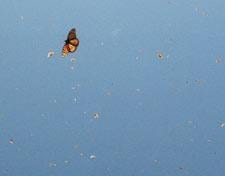The Power Plant’s summer show Universal Code, curated by director Gregory Burke, opened with a bang, although given the weather on the night of the opening reception, it looked a bit doubtful for a while. The reception-goers huddled under umbrellas in the pouring rain, waiting uncertainly for Cerith Wyn Evans’ fireworks display. There was a countdown and, sure enough, the text piece that the queer Welshman installed on the southern outdoor wall of the gallery exploded in bright orange flame.
The Power Plant hasn’t always been successful with its summer shows; they have tended, in recent years, to respond to the word “blockbuster” with arid conceptualism. But Burke has managed to buck that trend without abandoning any of the theoretical rigour that the Power Plant has come to be associated with. Universal Code is an ambitious show that assembles a wide roster of international artists, and while there is the occasional misstep, more often than not it brings together work that is warm and engaging.
The show’s premise is as wide as they come: the cosmos. The exhibition presents work (mostly installation, photography and video) marked by an interest in scientific developments: physics, astronomy, DNA research. Despite this almost absurd broadness, you can feel Burke’s firm curatorial grip throughout. Some work’s relationship to the theme might be more superficial than others, but there is rarely a sense that this or that artist’s presence here is arbitrary.
A pity then that the first work you encounter is the one piece in the show whose inclusion does seem arbitrary. Thomas Hirschhorn’s video suite Dancing Philosophy consists of him half-heartedly dancing behind a mannequin with the phrase “How do you dance to [insert philosopher’s name here]?” spray-painted on the wall behind him. It’s glib and shallow, barely a joke, not at all representative of Hirshchorn’s usual vast, engaging sculpture practice. It’s so out of place that you get the idea that Burke couldn’t get the piece he wanted and had to settle for this.
There are other such instances peppered throughout the show. On the second floor Josiah Mc-Elheny’s Island Universe, an installation of blown-glass chandeliers in the shape of galaxies, is present as a bit of (admittedly beautifully installed) video documentation. The most egregious example is Gabriel Orozco’s Black Kites sculpture, a skull on which Orozco drew a checkerboard pattern in graphite. The image of the skull is plastered all over the exhibition’s publicity material, and it turns out that that’s precisely what’s in the show: an eight by 10-inch photo of the skull and not, in fact, the real thing.
Still, these curatorial gaffes don’t unravel Universal Code. There’s plenty here worth seeing, and worth spending time with. Katie Paterson’s Earth-Moon-Earth provides a fitting soundtrack: a player piano makes its way through a shredded version of the Moonlight Sonata (she transcribed the score to Morse code, reflected it off the moon’s surface via radio waves and retranscribed the version that came back to Earth, full of wrong notes and missing chunks due to irregularities in the moon’s surface). Janet Cardiff and George Bures Miller’s Telephone/Time is a recorded phone conversation between Cardiff and a male mathematician on time and metaphysics. Between Cardiff’s close-talking purr and the mathematician’s low timbre and slow drawl, they sound like two lovers dirty-talking about the end of time.
Trevor Paglen’s Active Military and Reconnaissance Satellites of the United States of America is a gorgeous installation consisting of a glowing globe spinning in the middle of a darkened room, a dusting of glowing dots projected onto it representing the titular satellites. It’s an alluring combination of threat and womb-like intimacy. Kimsooja’s Mandala: Zone of Zero (three mandalas made out of jukeboxes, each pumping out Tibetan, Islamic and Gregorian chant, respectively) is hypnotic. Henrik Hakansson’s Monarch — The Eternal, a film loop of monarch butterflies filling the sky is a starkly simple, a gorgeous paean to life and migration cycles.
Wyn Evans (a former Derek Jarman collaborator) is present in three forms: a light installation on the second floor, a wall-sized text on the first floor and the aforementioned fireworks show. The fireworks were the best — a passage of text dealing with the relationship between music and the cosmos written out in hollowed metal tubing, the explosives inside. The piece was lit up, blazed and spat bright orange flames for a minute and left behind a cloud of smoke that reeked of burnt sulphur — magical in its own way. There was a cheesy grandeur to the whole thing, a kind of campy spectacle that took the piss out of the solemn hauteur of the text (and by extension, the po-faced solemnity of the entire show) with its fun-fair pyrotechnic display; a delightful way to begin a summer show and a summer.

 Why you can trust Xtra
Why you can trust Xtra


